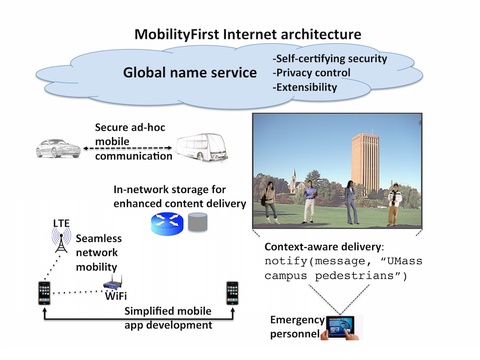A mobility-centric next-generation Internet

Mobile devices and apps have seen a phenomenal growth in the last few years and have transformed our daily lives. Today, the number of smartphones alone far exceeds the number of wired computers on the Internet, and Internet traffic from mobile devices (roughly doubling every year) is poised to exceed wired Internet traffic in a couple of years. Although the Internet has adapted remarkably to accommodate this growth, its core technology remains a legacy of its wired origins and suffers from several shortcomings. "From a mobile user's perspective, the Internet fails to satisfy seemingly straightforward expectations: a file download does not resume gracefully when moving from home to work; a smartphone voice-over-IP call does not seamlessly switch from WiFi at home to cellular on the road; and ad hoc mobile-to-mobile communication cannot be easily used to exchange data when the infrastructure network is congested or unavailable," says Associate Professor Arun Venkataramani. In fact, mobile data communication today is a one-way street wherein mobiles can initiate communication to fixed Internet servers but not the other way around. Existing on-paper approaches for Internet mobility (like Mobile IP) are based on an outdated cellular worldview that users have a single network home, are connected to a single access network at any time, require only device-to-device communication (rather than to content or other services), and move infrequently across networks.
Venkataramani's ongoing research on MobilityFirst, a next-generation Internet architecture, is addressing these shortcomings. As the Lead Architect of MobilityFirst, Venkataramani is coordinating this collaborative effort across seven other participating universities. MobilityFirst is driven by two critical high-level design goals: seamless mobility, i.e., the ability for devices, services, and content to communicate in a location-independent manner, and trustworthiness, i.e., assurance of security and privacy properties despite malicious behavior on part of a small fraction of endpoint or network nodes. "A key mechanism that helps enhance mobility as well as security is a clean separation of names or endpoint identifiers from addresses or their network locations," says Venkataramani. "By conflating the two in the form of IP addresses, the current Internet poorly supports mobility (same identity, changing locations), multihoming (single identity, multiple locations), and security because IP addresses can be easily hijacked or spoofed." In contrast, MobilityFirst uses distinct, self-certifying identifiers based on public key cryptography principles to represent endpoints and their network locations.
Although conceptually simple, realizing the above vision requires a massively scalable global name service to rapidly resolve arbitrary endpoint identifiers to network addresses. This resolution is somewhat similar in spirit to how the Internet's Domain Name System (DNS) resolves domain names (like "www.cs.umass.edu") to IP addresses (like 128.119.240.84). However, unlike DNS that is designed for a world where name-to-address mappings rarely change and any updates take hours or days to propagate, MobilityFirst's global name service must address the challenge of designing a geo-distributed system that allows tens of billions of endpoint identifiers to update their network addresses many times a day. Venkataramani and his collaborators have addressed this difficult challenge and, in the process, established a key architectural insight, namely that a logically centralized (but physically distributed) global name service can dramatically enhance not only mobility and security but also basic network communication primitives.
An example of an enhanced network communication primitive in MobilityFirst is context-aware delivery that enables sending a message to abstract contextual descriptors of the form "all pedestrians on the UMass Amherst campus." Unlike the Internet that only supports the ability to send a message to an IP address, context-aware delivery allows app developers to use group communication primitives without having to explicitly manage the group or even know of the members of the group, saysVenkataramani. The global name service in MobilityFirst also enhances several other function such as content retrieval, multihomed traffic engineering, locating the nearest replica of a service, network management, etc. thereby simplifying the job of app developers and network operators while improving end-user experience. An app developer portal for MobilityFirst is at http://gns.name.
The next-generation Internet insights, illustrated above, build upon Venkataramani's research on mobile and wireless systems as well as content delivery. His prior research has developed strategies to augment cellular connectivity with WiFi in vehicular scenarios. He has analyzed tradeoffs between performance, data usage cost, and battery power consumption in such multiplexed wireless access scenarios. His work has also shown the feasibility, performance, and robustness benefits of using in-network storage in routing and transport protocols in vehicular networks where nodes may be only intermittently connected.
Venkataramani's ongoing and recent work on content delivery is the first to formally study the rapidly growing phenomenon of "content distribution networks (CDNs)". The traditional way of delivering content on the Internet used to be for content providers (like NetFlix or nytimes.com) to outsource delivery to CDNs (like Akamai or Limelight) that deliver content over networks (ISPs like Comcast or AT&T). Recent and potentially disruptive industry trends are pushing the growth of network CDN wherein the network also owns and manages a CDN service. Such content-aware networks not only enhance user-perceived performance but also significantly increase opportunities for network operators to reduce their costs as they can place content at strategic locations and redirect users' traffic accordingly instead of having to manage "dumb bits" over which they have little control. Venkataramani's research has been developing strategies for content-aware networking in ISP-scale networks as well as data center networks.
Venkataramani joined UMass Amherst in 2005 after completing his Ph.D. in Computer Sciences at the University of Texas at Austin in 2004 and a Visiting Faculty appointment at the University of Washington. He received his bachelor's degree in Computer Science and Engineering at IIT Bombay in 1999. He is a recipient of an NSF CAREER award and his work has received several best paper awards at venues including USENIX NSDI and ACM SIGCOMM CoNEXT.